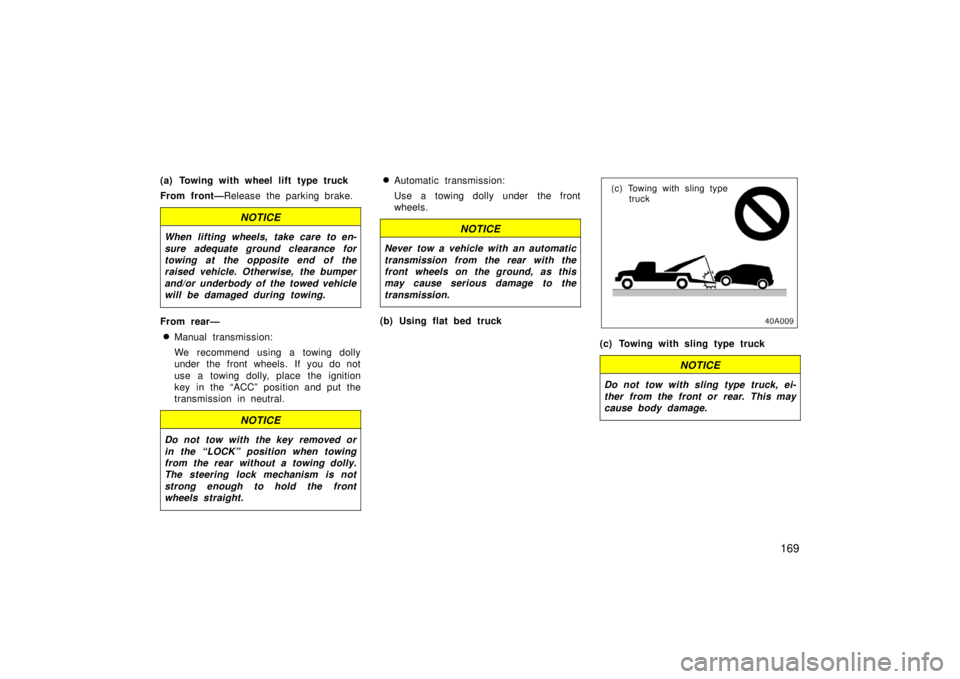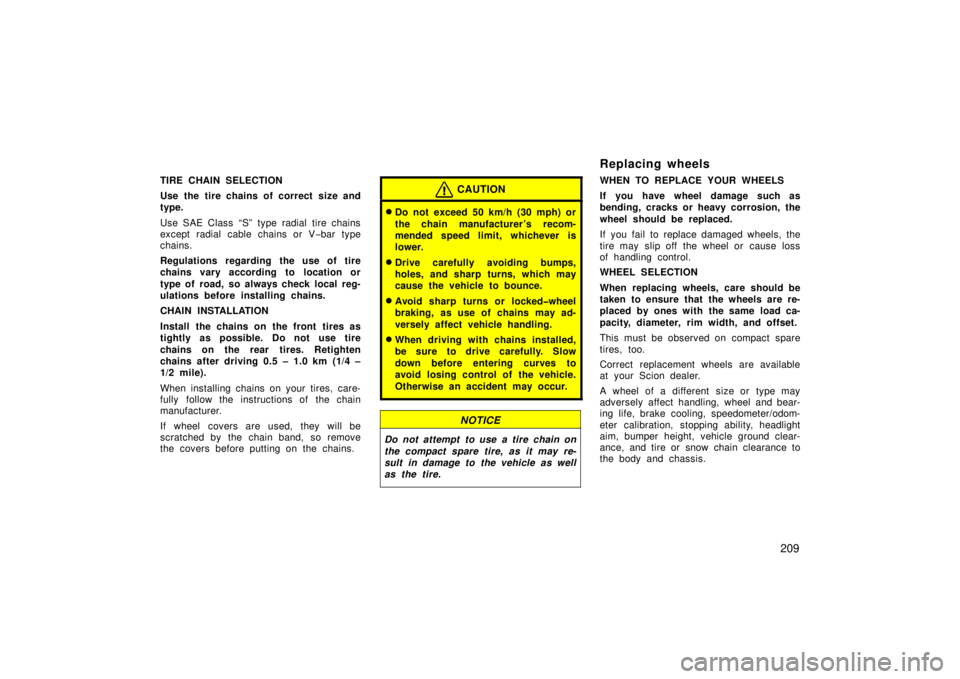Page 169 of 244
161
NOTICE
Your ground clearance is re-
duced when the compact spare
tire is installed so avoid driving
over obstacles and drive slowly
on rough, unpaved roads and
speed bumps. Also, do not at-
tempt to go through an auto-
matic car wash as the vehicle
may get caught, resulting in
damage.
40A032
1. Open the luggage storage box
and get the required tools and
spare tire.
1. Wheel nut wrench
2. Jack handle
3. Tool bag
4. Spare tire
To open the luggage storage box, see
“Luggage storage box” on page 114.
You will find a jack and a flat tire bolt
in the tool bag. To prepare yourself for an emergency,
you should familiarize yourself with
the use of the jack, each of the tools
and their storage locations.
—R eq u ired to o ls an d sp are
tire
Page 172 of 244
164
—Positioning the jack
4. Position the jack at the correctjack point as shown.
Make sure the jack is positioned on
a level and solid place.
—Raising your vehicle
5. After making sure that no one is in the vehicle, raise it high
enough so that the spare tire
can be installed.
Remember you will need more ground
clearance when putting on the spare
tire than when removing the flat tire.
To raise the vehicl e, insert the jack
handle into the jack (it is a loose fit)
and turn it clockwise. As the jack
touches the vehicle and begins to lift,
double −check that it is properly posi-
tioned.
CAUTION
Never get under the vehicle when
the vehicle is supported by the
jack alone.
Page 177 of 244

169
(a) Towing with wheel lift type truck
From front—Release the parking brake.
NOTICE
When lifting wheels, take care to en-
sure adequate ground clearance for
towing at the opposite end of the
raised vehicle. Otherwise, the bumper
and/or underbody of the towed vehicle
will be damaged during towing.
From rear—
�Manual transmission:
We recommend using a towing dolly
under the front wheels. If you do not
use a towing dolly, place the ignition
key in the “ACC” position and put the
transmission in neutral.
NOTICE
Do not tow with the key removed or
in the “LOCK” position when towing
from the rear without a towing dolly.
The steering lock mechanism is not
strong enough to hold the front
wheels straight.
�Automatic transmission:
Use a towing dolly under the front
wheels.
NOTICE
Never tow a vehicle with an automatic
transmission from the rear with the
front wheels on the ground, as this
may cause serious damage to the
transmission.
(b) Using flat bed truck
(c) Towing with sling type
truck
(c) Towing with sling type truck
NOTICE
Do not tow with sling type truck, ei-
ther from the front or rear. This may
cause body damage.
Page 214 of 244

206 The tires on your Scion have built−in
tread wear indicators to help you
know when the tires need replace-
ment. When the tread depth wears to
1.6 mm (0.06 in.) or less, the indica-
tors will appear. If you can see the
indicators in two or more adjacent
grooves, the tire should be replaced.
The lower the tread, the higher the
risk of skidding.
The effectiveness of snow tires is
lost if the tread wears down below
4 mm (0.16 in.).
If you have tire damage such as
cuts, splits, cracks deep e nough to
expose the fabric, or bulges indi-
cating internal damage, the tire
should be repl aced.
If a tire often goes flat or cannot be
properly repaired due to the size or
location of a cut or other damage, it
should be replaced. If you are not
sure, consult with your Scion dealer.
If air loss occurs while driving, do not
continue driving. Driving even a short
distance can damage a tire beyond
repair. An y ti res wh i ch are over 6 years
old must be checked by a qualified
technician even if damage is not
obvious.
Tires deteriorate with age even if they
have never or seldom been used.
This applies also to the spare tire and
tires stored for future use.
REPLACING YOUR TIRES
When replacing a tire, use a tire of
the same size and construction,
and the same or greater maximum
load as the originally installed
tires.
Using any other size or type of tire
may seriously affect handling, ride,
speedometer/odometer calibration,
ground clearance, and clearance be-
tween the body and tires or snow
chains.
Check that the maximum load of the
replaced tire is greater than 1/2 of the
Gross Axle Weight Ratings (GAWR)
of either the front axle or the rear
axle, whichever is greater. As for the
maximum load of the tire, see the load
limit at maximum cold tire inflation
pressure mentioned on the sidewall
of the tire, and as for the Gross Axle
Weight Ratings (GAWR), see the Cer-
tification Label. For details about the
sidewall of the tire and the Certifica-
tion Label, see pages 129 and 127.
Page 217 of 244

209
TIRE CHAIN SELECTION
Use the tire chains of correct size and
type.
Use SAE Class “S” type radial tire chains
except radial cable chains or V−bar type
chains.
Regulations regarding the use of tire
chains vary according to location or
type of road, so always check local reg-
ulations before installing chains.
CHAIN INSTALLATION
Install the chains on the front tires as
tightly as possible. Do not use tire
chains on the rear tires. Retighten
chains after driving 0.5 – 1.0 km (1/4 –
1/2 mile).
When installing chains on your tires, care-
fully follow the instructions of the chain
manufacturer.
If wheel covers are used, they will be
scratched by the chain band, so remove
the covers before putting on the chains.CAUTION
�Do not exceed 50 km/h (30 mph) or
the chain manufacturer ’s recom-
mended speed limit, whichever is
lower.
�Drive carefully avoiding bumps,
holes, and sharp turns, which may
cause the vehicle to bounce.
�Avoid sharp turns or locked�wheel
braking, as use of chains may ad-
versely affect vehicle handling.
�When driving with chains installed,
be sure to drive carefully. Slow
down before entering curves to
avoid losing control of the vehicle.
Otherwise an accident may occur.
NOTICE
Do not attempt to use a tire chain on
the compact spare tire, as it may re-
sult in damage to the vehicle as well
as the tire.
Replacing wheels
WHEN TO REPLACE YOUR WHEELS
If you have wheel damage such as
bending, cracks or heavy corrosion, the
wheel should be replaced.
If you fail to replace damaged wheels, the
tire may slip off the wheel or cause loss
of handling control.
WHEEL SELECTION
When replacing wheels, care should be
taken to ensure that the wheels are re-
placed by ones with the same load ca-
pacity, diameter, rim width, and offset.
This must be observed on compact spare
tires, too.
Correct replacement wheels are available
at your Scion dealer.
A wheel of a different size or type may
adversely affect handling, wheel and bear-
ing life, brake cooling, speedometer/odom-
eter calibration, stopping ability, headlight
aim, bumper height, vehicle ground clear-
ance, and tire or snow chain clearance to
the body and chassis.